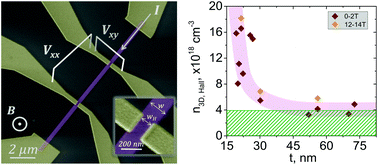Bulk-free topological insulator Bi2Se3 nanoribbons with magnetotransport signatures of Dirac surface states†
Abstract
Many applications of topological insulators (TIs) as well as new phenomena require devices with reduced dimensions. While much progress has been made to realize thin films of TIs with low bulk carrier densities, nanostructures have not yet been reported with similar properties, despite the fact that reduced dimensions should help diminish the contributions from bulk carriers. Here we demonstrate that Bi2Se3 nanoribbons, grown by a simple catalyst-free physical-vapour deposition, have inherently low bulk carrier densities, and can be further made bulk-free by thickness reduction, thus revealing the high mobility topological surface states. Magnetotransport and Hall conductance measurements, in single nanoribbons, show that at thicknesses below 30 nm, the bulk transport is completely suppressed which is supported by self-consistent band-bending calculations. The results highlight the importance of material growth and geometrical confinement to properly exploit the unique properties of topological surface states.



 Please wait while we load your content...
Please wait while we load your content...